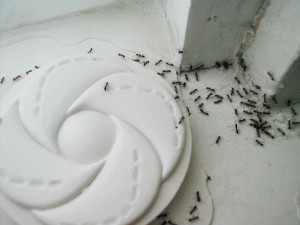Carpenter Ants May Require Multiple Approaches
By Chris Williams on October 28, 2014.
I’ve asked several different exterminators what they do to kill carpenter ants, but I can’t get a good answer. Some bait, some spray, some don’t want to say. Is it a big secret? Can you tell me what method your company uses to control carpenter ants in a house? N. E., Bow, NH
There actually is no one method that we always use for carpenter ants, because the best control is often a combination of methods. At Colonial, we evaluate each carpenter ant problem individually and then decide on the best approach for the situation. I’m happy to tell you about some of the methods we use to kill carpenter ants.
The Emphasis is on Finding the Nests
Carpenter ants are difficult to control because, to do it right, you really need to find their nests…and that’s not always possible. Nests can be either inside the structure, or outside. If we locate the ants’ nest (or nests), we can inject the nest directly with a residual insecticide spray or dust to kill ants in the nest, as well as those returning to the nest.
Baits Are a Useful Option
When we have foraging carpenter ants but we don’t know the location of the nests, we will apply ant baits in an attempt to affect the colony indirectly. The carpenter ants will feed on the bait and carry the bait back to the colony to feed it to others, including the queen. We place the baits along the ants’ foraging trails outside and at points where they are entering the home.
Baits take longer to work than insecticide sprays or dusts because the ants have to carry the bait back to the colony. The insecticide in ant baits is also slower acting because you don’t want to kill the foraging ants before they can supply the colony with bait. We will often use ant bait in combination with an insecticide residual treatment.
Insecticide Treatments Intercept Foraging Ants
We may apply an insecticide treatment either inside or outside, or both, depending on what we find. Insecticide may be applied as a perimeter treatment around the outside foundation of your home to intercept ants that are moving in from outside. We might treat around door and window frames and under siding. Inside, insecticide dust could be applied in wall voids, especially if we suspect that there is a nest there. We might also treat along baseboards and other areas where we have seen ants trailing.
You don’t say whether you have a carpenter ant problem or if you know someone who does. Give us a call. We’re always willing to work with the customer when we design an ant control program. See more about carpenter ants under Services on our home page or in our blog Why Do I Have Carpenter Ants in My House?
By Thmazing [Public domain], via Wikimedia Commons
